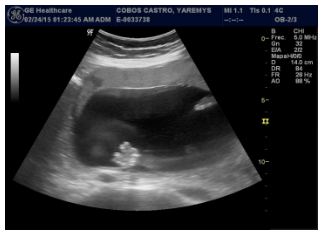Thanatophoric dysplasia: case presentation
Keywords:
THANATOPHORIC DYSPLASIA, PREGNANCY, DWARFISM.Abstract
Introduction: thanatophoric dysplasias are characterized by narrow thorax with platyspondyly (flattening of vertebral bodies) and short limbs.
Clinical case: a case of lethal skeletal dysplasia is presented in one of the varieties known as type I thanatophoric dysplasia. A 32-year-old female with 22 weeks of gestation came to the ultrasound service at Copacabana Health Center in Alto, La Paz to perform ultrasound screening, where a male fetus with shortening of long bones in handset-phone shape, short fingers and narrow chest in relation to the abdomen were observed.
Conclusions: type I thanatophoric dysplasia was confirmed, genetic counseling was given and pregnancy termination was decided as a fetal abnormality incompatible with life.
Downloads
References
1. Nelson DB, Dashe JS, McIntire DD, Twickler DM. Fetal skeletal dysplasias: sonographic indices associated with adverse outcomes. J Ultrasound Med [revista en la Internet].2014 Jun [citado 2015 Jul 24]; 33(6):1085-90. doi: 10.7863/ultra.33.6.1085. Disponible en: http://www.jultrasoundmed.org/content/33/6/1085.abstract
2. Chitty LS, Khalil A, Barrett AN, Pajkrt E, Griffin DR, Cole TJ. Safe, accurate, prenatal diagnosis of thanatophoric dysplasia using ultrasound and free fetal DNA. Prenat Diagn [revista en la Internet]. 2013 May [citado 2015 ago 24]; 33(5):416-23. doi: 10.1002/pd.4066. Disponible en: http://www.ncbi.nlm.nih.gov/pubmed/?term=Safe%2C+accurate%2C+prenatal+diagnosis+of+thanatophoric+dysplasia+using+ultrasound+and+free+
3. Calder AD, Offiah AC. Fetal radiography for suspected skeletal dysplasia: technique, normal appearances, diagnostic approach. Pediatr Radiol [revista en la Internet]. 2015 Apr [citado 2016 jun 12]; 45(4):536-48. doi: 10.1007/s00247-014-3130-x. Disponible en: http://link.springer.com/article/10.1007/s00247-014-3130-x
4. Carvajal N, Martínez-García M, Chagoyen M, Morcillo N, Pino A, Lorda I, Trujillo-Tiebas MJ. Clinical, genetics and bioinformatics characterization of a campomelic dysplasia case report.Gene. j.gene [revista en la Internet]. 2016 Feb [citado 2016 jun 15]; 577(2):289-92. doi: 10.1016/j.gene.2015.11.039. Disponible en: http://www.ncbi.nlm.nih.gov/pubmed/26631621
5. Barros CA, Rezende GC, Araujo Júnior E, Tonni G, Pereira AK. Prediction of lethal pulmonary hypoplasia by means fetal lung volume in skeletal dysplasias: a three-dimensional ultrasound assessment. J Matern Fetal Neonatal Med [revista en la Internet]. 2016 Jul [citado 2016 jul 15]; 29 Issue 11: 1-6. [Epub ahead of print. Disponible en: http://www.tandfonline.com/doi/abs/10.3109/14767058.2015.1064887
6. Heinrich T, Nanda I, Rehn M, Zollner U, Ernestus K, Wirth C, Schlüter G, Schmid M, Kunstmann E. Co-Occurence of Reciprocal Translocation and COL2A1 Mutation in a Fetus with Severe Skeletal Dysplasia: Implications for Genetic Counselin. Cytogenet Genome Res. [revista en la Internet]. 2015 mar [citado 2015 oct 15]; 145(1):25-8. doi: 10.1159/000381169. Epub 2015 Mar 25. Disponible en: http://www.ncbi.nlm.nih.gov/pubmed/25823796
7. Unanue M N, Moenne B K, Baar Z A. Manejo de Displasias Esqueléticas
Revista Médica Clínica Las Condes[revista en la Internet]. 2015 abr [citado 2015 oct 15]; 26 Issue 4: 470-482. Disponible en: http://www.sciencedirect.com/science/article/pii/S0716864015000954

Published
How to Cite
Issue
Section
License
Authors who have publications with this journal agree to the following terms: Authors will retain their copyrights and grant the journal the right of first publication of their work, which will be publication of their work, which will be simultaneously subject to the Creative Commons Attribution License (CC-BY-NC 4.0) that allows third parties to share the work as long as its author and first publication in this journal are indicated.
Authors may adopt other non-exclusive license agreements for distribution of the published version of the work (e.g.: deposit it in an institutional telematic archive or publish it in a volume). Likewise, and according to the recommendations of the Medical Sciences Editorial (ECIMED), authors must declare in each article their contribution according to the CRediT taxonomy (contributor roles). This taxonomy includes 14 roles, which can be used to represent the tasks typically performed by contributors in scientific academic production. It should be consulted in monograph) whenever initial publication in this journal is indicated. Authors are allowed and encouraged to disseminate their work through the Internet (e.g., in institutional telematic archives or on their web page) before and during the submission process, which may produce interesting exchanges and increase citations of the published work. (See The effect of open access). https://casrai.org/credit/


